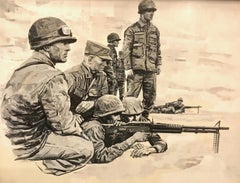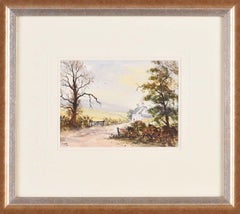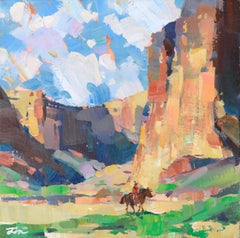Charles Ellis Figurative Drawings and Watercolors
to
2
1
Overall Width
to
Overall Height
to
3
1
2
1
3
3
2
1
1
1
1
1
3
2
1
1
1
19
938
319
238
192
1
3
Artist: Charles Ellis
Military Illustration
By Charles Ellis
Located in Fort Washington, PA
Medium: Ink on Board
Signature: Signed Lower Left
Contact for dimensions.
Category
20th Century Charles Ellis Figurative Drawings and Watercolors
Materials
Ink, Board
Victorian Memories
By Charles Ellis
Located in Fort Washington, PA
Medium: Watercolor on Board
Dimensions: 18.00" x 12.00"
Signature: Unsigned
Category
Late 20th Century Charles Ellis Figurative Drawings and Watercolors
Materials
Watercolor, Board
A Year in Review: 1969
By Charles Ellis
Located in Fort Washington, PA
Date: 1969
Medium: Pen and Ink on Board
Dimensions: 24.00" x 16.00"
Signature: Unsigned
Category
1960s Charles Ellis Figurative Drawings and Watercolors
Materials
Ink, Board, Pen
Related Items
Original Watercolour of Farmhouse in the Northern Ireland Countryside
Located in Preston, GB
Original Watercolour of Farmhouse in the Northern Ireland Countryside by 20th Century Irish Artist, D Hall
Art measures 8 x 6 inches
Frame measure...
Category
Late 20th Century Impressionist Charles Ellis Figurative Drawings and Watercolors
Materials
Board, Archival Paper, Watercolor
$648 Sale Price
20% Off
H 15 in W 16 in D 1 in
Cowboy in the Canyon, Small Contemporary Multicolor Abstract Figural Landscape
By Tiffanie Mang
Located in Soquel, CA
Small-scale yet bold multi-colored abstracted figurative landscape of a horse rider in a canyon (a study after Edgar Payne’s works) by Tiffanie Mang (Ameri...
Category
2010s American Impressionist Charles Ellis Figurative Drawings and Watercolors
Materials
Gouache, Cardboard
$875
H 9.5 in W 9.5 in D 0.13 in
Figure Studies
Located in London, GB
Pen and ink on paper
23cm × 16cm (42cm × 33cm framed)
Provenance:
From the collection of Michael Leonard
First exhibiting at the RA in 1904, Philpot was elected as an Academician i...
Category
Early 20th Century Charles Ellis Figurative Drawings and Watercolors
Materials
Ink, Pen, Paper
Soviet Union pro-natalist communist Bulgarian propaganda poster design
Located in London, GB
To see more, scroll down to "More from this Seller" and below it click on "See all from this Seller."
Bulgarian pro-natalist propaganda poster design (circa 1950s)
Gouache on board
17 x 12 cm
After a Communist takeover in 1945, Bulgaria was a Soviet ally during the Cold War, and maintained good relationships with Russia until the Revolutions of 1989. From 1945 to 1948, the country became entrenched within the Soviet sphere of influence under the control of the Bulgarian Communist Party (BCP) which oversaw a program of Stalinization in the late 1940s and 1950s. Both countries are Slavic nations, and are bound together by a common Orthodox Christian...
Category
20th Century Modern Charles Ellis Figurative Drawings and Watercolors
Materials
Gouache, Board
$449
H 6.7 in W 4.73 in
Mother and Child - Drawing - 1962
Located in Roma, IT
Mother and Child is an artwork realized by an unknown artist in 1962.
Black Marker Pen on Cardboard
27.5 x 22.5 cm ; 60 55 cm with frame.
Unreadable signature in the lower part.
...
Category
1960s Contemporary Charles Ellis Figurative Drawings and Watercolors
Materials
Board, Pen
Art Nouveau Illustration Women and Children in the Woods
Located in Miami, FL
Complex Art Nouveau patterns intertwined with gracefull figures define this work by American Artist and illustrator, teacher and lecturer Mildred Bailey Carpenter. Signed in cartouc...
Category
1920s Art Nouveau Charles Ellis Figurative Drawings and Watercolors
Materials
Gouache, Paper, Board
$10,000
H 10 in W 7.5 in D 1 in
Two Drawings
By Louis Valtat
Located in New York, NY
Group of two drawings. "Femme assise sur une Chaise," circa 1910. Brush and ink on wove paper, 8 1/2x8 inches. With the artist's initials ink stamp, lower right recto.
"Femme avec ...
Category
1910s Fauvist Charles Ellis Figurative Drawings and Watercolors
Materials
Ink, Pen
'Age 9', Art Deco, Woman Artist, AIC, ASL, Paris, Salon d'Automne, Corcoran
By Nura Ulreich
Located in Santa Cruz, CA
Painted by Nura Woodson Ulreich (American, 1899-1950) as a full-page illustration for the book 'The Buttermilk Tree', unsigned and dated circa 1935. A rare example of a fully-develop...
Category
1930s Charles Ellis Figurative Drawings and Watercolors
Materials
Gouache, Illustration Board, Pen, Pencil
$5,500
H 11.25 in W 9.25 in
WPA Post Office Mural Study American Scene Regionalism Social Realism Modern Art
By Louise Ronnebeck
Located in New York, NY
WPA Post Office Mural Study American Scene Regionalism Social Realism Modern Art
Louise Emerson Ronnebeck (1901 - 1980)
Oil Riggers, Mural Study
Image: 6 1/2 x 37 inches
Watercolor ...
Category
1930s American Modern Charles Ellis Figurative Drawings and Watercolors
Materials
Watercolor, Cardboard, Paper
Harvest Time The Hills of Mt Tamalpais near Lake Bon Tempe 1890s
Located in Soquel, CA
Harvest Time The Hills of Mt Tamalpais near Lake Bon Tempe 1890s
The Hills around San Rafael in the 19th century were a time of work and play as seen in this watercolor near Lake Bon...
Category
Late 19th Century American Impressionist Charles Ellis Figurative Drawings and Watercolors
Materials
Watercolor, Illustration Board, Laid Paper
$1,800
H 21.75 in W 11.5 in D 0.07 in
Cuban Artist - Caricature of Adolphe Menjou Debonair Devil
Located in Miami, FL
Framed Cuban Artist/Caricaturist Conrado Walter Massaguer presents Hollywood star Adolphe Menjou in a satirical dual portrait. In the foreground, the subject is seen in a dapper top hat, tux, fashionable cigarette and boutonnière, and is shown as being the epitome of being stylishly debonair. To make a larger point about this subject, Massaguer paints a cast shadow of Menjou as a burning red devil who studies his alter ego from above. Keeping with the artist's sarcasm, we see the good and bad in one image. Works by Massaguer are rare and this work is in keeping with his signature style. This work was most likely done on assignment for Life Magazine, Cosmopolitan, The New Yorker or Vanity Fair. Signed upper right. Inscribe lower right. Titled on verso. Unframed, Slight bend to board; toning to board; scattered faint foxing; pin point abrasions to margins, not affecting image. 19-1/2 x 15-1/8 inches board size.
Conrado Walter Massaguer y Diaz was a Cuban artist, political satirist, and magazine publisher. He is considered a student of the Art Nouveau. He was the first caricaturist in the world to broadcast his art on television.He was first caricaturist to exhibit on Fifth Avenue. He was the first caricaturist in the world to exhibit his caricatures on wood. He, and his brother Oscar, were the first magazine publishers in the world to use photolithographic printing.
Self portrait of Conrado Walter Massaguer, depicted on a carrousel ride, with the devil over his left shoulder and an angel over his right. (1945)
He created the magazine Social with his brother Oscar to showcase Cuban artistic talent. The duo later created the magazine Carteles, which became for a period the most popular magazine in Cuba, which was purchased by Miguel Ángel Quevedo in 1953.
In his life, he met and drew caricatures of Franklin D. Roosevelt, Walt Disney, Albert Einstein, the King of Spain, and many others.[ In sum total, he was the author of more than 28 thousand caricatures and drawings.Ernest Hemingway once had to refrain himself from punching Massaguer in the face after the artist drew an unflattering caricature of him. The dictator Gerardo Machado, however, did not punch Massaguer for his own unflattering caricature - he had the artist deported.
He was one of the most internationally renowned Cuban artists of his day, and his art is still regularly featured in galleries across the Western Hemisphere and Europe.
Early life
Massaguer was born on October 18, 1889, in Cárdenas, Cuba.[In 1892, his family moved to Havana.
When the Cuban War of Independence broke out, Massaguer's family escaped the country. From 1896 to 1908, he lived in Mérida, Mexico. However, during this time, his parents enrolled him in the New York Military Academy, where he stayed during school years.
In 1905, after graduating the military academy, he briefly attended the San Fernando school in Havana, where he was tutored by Ricardo de la Torriente and Leopoldo Romañach.
In 1906, less than a year later, he returned to the family home in Mexico.
Career as artist
Early career
While living in Yucatán, Mexico, Massaguer published his first caricatures in local newspapers and magazines. These included La Campana, La Arcadia, and the Diario Yucateco.
In 1908, he moved back to Havana. After returning to the island in 1908, Massaguer began mingling with Havana's aristocratic circles, forming close friendships with some of the city's most powerful and influential men, as well as winning the favor of many women who were quickly charmed by him. Massaguer, largely self-taught, honed his style using the avant-garde techniques he studied from the European and American magazines that were widely available in Cuba at the time.
Cover of the immensely popular Cuban magazine El Figaro, drawn by Massaguer in 1909. This cover depicts two bumbling, incompetent American tourists to the island.
He started drawing for El Fígaro, and was featured prominently on the cover in 1909.
After two years of refining his craft, Havana announced a poster contest aimed at attracting North American tourists to stay in the city during the winter months. Notable figures like Leopoldo Romañach, Armando Menocal, Rodríguez Morey, Jaime Valls, and others also entered the competition. The jury was particularly impressed by the modern execution and creative solution of one piece, signed by Massaguer, who was relatively unknown at the time.
The jury deliberations caused a great controversy.[5] The prize was ultimately awarded to the Galician painter Mariano Miguel, who had recently married the daughter of Nicolás Rivero, the wealthy owner of the conservative newspaper Diario de la Marina. Although Massaguer received only an honorable mention, the fraud scandal caused such an uproar that his name quickly entered the public spotlight, and he became an overnight sensation.
In 1910, he became co-owner of the advertising agency Mercurio, with Laureano Rodríguez Castells. At Mercurio, he led the Susini cigar campaign, and earned substantial wealth.
Massaguer has been described as a restless man, in both mind and body.After earning enough money from his art to begin traveling, he was almost always doing so. He constantly traveled between New York City and Havana, Mexico and France, Europe and the Americas.
In 1911, his reputation among the Havana socialites solidified when he organized his own first public caricature exhibit, and also the first Caricature Salon ever held in the Americas, hosted at Athenaeum of Havana (the Ateneo), and the Círculo de La Habana. Other exhibitors here included Maribona, Riverón, Portell Vilá, Valer, Botet, Barsó, García Cabrera, Carlos Fernández, Rafael Blanco, and Hamilton de Grau.
"Messaguer Visits Broadway." Caricatures of theatrical and literary figures. Elsie Janis, Raymond Hitchcock, S. Jay Kaufman (columnist), Ibanez, author of The Four Horsemen, and Frances White
In 1912, in the New York American Journal, he published his first Broadway drawings.
From 1913 to 1918, he was an editor for Gráfico.
Social
Main article: Social (magazine)
Cover of the magazine Social, July 7, 1923
In 1916, he created the magazine Social with his brother, Oscar H. Massaguer. Social's contributors included Guillén Carpentier, Chacón y Calvo, Enrique José Varona and others.Social has been described as Massaguer's great love in the magazine industry, and was the property that historians say he cared the most about. Social was an innovative magazine, being the first magazine in the world to use a modern printing process called photolithographic printing.
Social set cultural trends, not only in the fashion of Cuba, but in art, politics, and Cuban identity.[11] Social catered to a certain aesthetic in Cuba - that of the sophisticated elite socialite - but Massaguer would also use this magazine to ridicule and jibe against that same class of society when he found their personalities worthy of his contempt.
In Social, readers could find a variety of content, including short stories, avant-garde poetry, art reviews, philosophical essays, and serialized novels, as well as articles on interior design, haute couture, and fashion. Occasionally, the magazine also featured reports on sports such as motor racing, rowing, tennis, and horse riding.The cultural promotion efforts of both Massaguer and Emilio Roig de Leuchsenring are evident in the magazine. Notably, this period overlaps with their involvement in the Minorista Group, which was then at the forefront of the country's intellectual life.[5] Many contributors were devoted members of the group, leading some experts to consider Social as the cultural voice of the Minoristas.
One of the features of Social magazine was its section called "Massa Girls," which was a play on his own name, and pronounced with a glottal 'g' in a similar fashion to the letter in Massaguer.[12] Massaguer drew women as independent and free-thinking, and never drew the woman celebrity as a caricature of herself, but as a free agent surrounded by caricatures.[11] However, Massaguer himself has been described as a womanizer in his personal life, and hesitant to fully embrace every facet of women's liberation.
In 1916, he also established la Unión de Artes Gráficas and the advertising agency Kesevén Anuncios.[9]
The art critic Bernardo González Barroa wrote:
“Massaguer has solved the problem of working hard, living comfortably off what his art produces and not missing any artistic, sporting or social event. His broad, childish laugh, of a carefree individual who carries his luck hidden in a pocket, appears everywhere for the moment, disguising the pranks of pupils that lurk, mock and, finally, flash with satisfaction at finding the characteristic point after having analyzed a soul... Massaguer's personality is beginning to solidify now. He has been the best-known and most popular caricaturist for a long time, but his technique had not reached the security, the mastery of values that he presents in his latest works, which is very natural and explainable”[5]
Carteles
Main article: Carteles
Cover of the magazine Carteles, November 29, 1931
In 1919, Massaguer and his brother created the magazine Carteles.[9] Carteles gained the widest circulation of any magazine in Latin America, and the most popular magazine in Cuba for a time, until that title was claimed by Revista Bohemia. Carteles remained in print until July 1960.This magazine showcased Cuban commerce, art, sports, and social life before the revolution.
In 1924, Carteles took a more political turn, with articles criticizing Gerardo Machado's government. it became a prime example of the humor and graphic design employed by artists like Horacio Rodríguez Suria and Andrés García...
Category
1930s Art Nouveau Charles Ellis Figurative Drawings and Watercolors
Materials
Watercolor, Ink, Illustration Board
$12,500
H 16.38 in W 12.5 in
Jonas Wood 24 Tennis Court Drawings monograph (hand signed, inscribed and dated)
By Jonas Wood
Located in New York, NY
Jonas Wood 24 Tennis Court Drawings book (hand signed, inscribed to Kevin and dated by the artist)
Hardback monograph (signed, inscribed and dated 2003)
13 1/2 × 9 1/4 × 2/5 inches
M...
Category
2010s Contemporary Charles Ellis Figurative Drawings and Watercolors
Materials
Board, Mixed Media, Permanent Marker, Lithograph, Offset
$2,030
H 13.5 in W 9.25 in D 0.4 in
Charles Ellis figurative drawings and watercolors for sale on 1stDibs.
Find a wide variety of authentic Charles Ellis figurative drawings and watercolors available for sale on 1stDibs. You can also browse by medium to find art by Charles Ellis in board, ink, paint and more. Not every interior allows for large Charles Ellis figurative drawings and watercolors, so small editions measuring 1 inch across are available. Customers who are interested in this artist might also find the work of Patricia A Pearce, Anne Muntges, and Katherine Librowicz. Charles Ellis figurative drawings and watercolors prices can differ depending upon medium, time period and other attributes. On 1stDibs, the price for these items starts at $750 and tops out at $1,500, while the average work can sell for $1,250.
Artists Similar to Charles Ellis
Jean Baptiste Édouard Detaille


